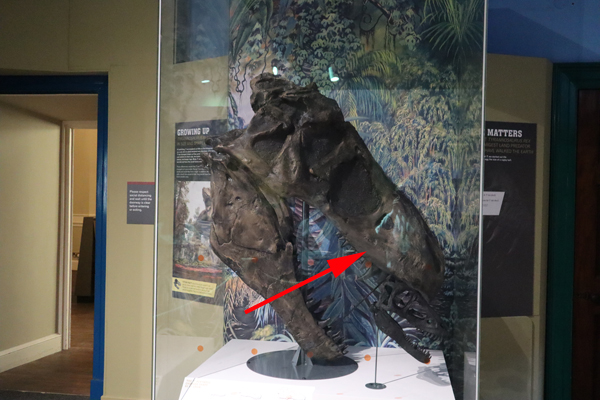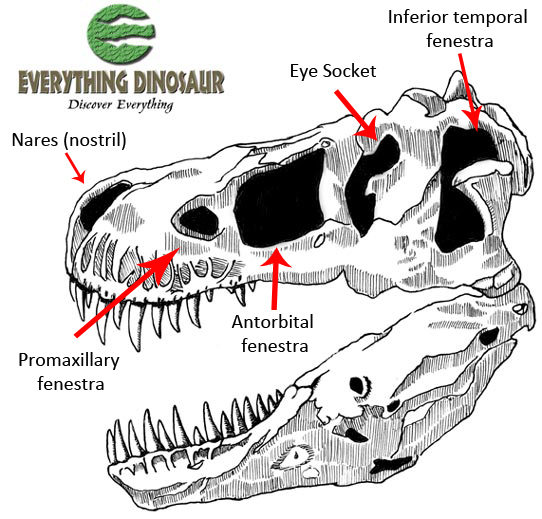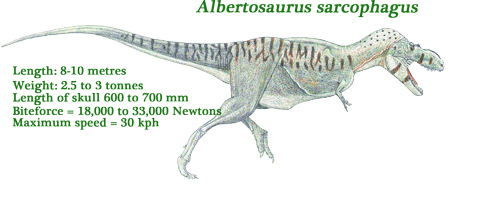Tyrannosaur Skull from British Columbia
Hiker Finds Part of a Tyrannosaur Skull Near Tumbler Ridge
Fossil hunter Rick Lambert was hiking in the Tumbler Ridge area of British Columbia when he spotted an unusual object partially exposed in a large rock. It turns out the eagle-eyed chiropractor from Vancouver Island had found the maxilla bone from a tyrannosaur skull. The maxilla is part of the upper jaw, this fossil and the teeth/teeth sockets that it contains, can help palaeontologists to identify the type of dinosaur down to genus level.
Tyrannosaur Skull Bone
This is the first dinosaur skull fossil material to have been found in this area and although the one-hundred-kilogram rock containing the fossil is not part of the local strata, it was probably moved to the site as part of a landscaping project, it’s discovery could help scientists to better understand the geographic distribution of a genus of tyrannosaur from the Late Cretaceous.
The Tumbler Ridge Tyrannosaur Skull Fossil (Maxilla)

An adult T. rex and a juvenile T. rex skull cast on display. The maxilla bone has been highlighted in the adult skull fossil cast. Picture credit: Everything Dinosaur.
Picture credit: Everything Dinosaur
A Significant Tyrannosaur Fossil Find
Large theropod footprints have been found in the Tumbler Ridge area in the past, indeed, this location has provided the palaeontologists based at the Peace Region Palaeontology Research Centre, which was established back in 2003 to study the fossils, with hundreds of dinosaur teeth, fragmentary bones as well as the remarkable trace fossils, but this upper jaw bone could be a real game changer for the region.
The director of the Peace Region Palaeontology Research Centre, Richard McCrea commented:
“We are in a frontier in British Columbia because there’s been no research in this area. This is quite a jump for us.”
Having studied and worked in geology, Rick Lambert knew he had found something significant, but he had no idea how important his fossil find could prove to be. Rick was used to finding fossils in the area, but he wasn’t expecting to find a bone from the skull of a theropod dinosaur, a skull that would have measured more than a metre in length.
Rick explained:
“I never expected to find something like that. It’s not anything I actually kept my eye out for. I thought at least they would have four or five of those in a drawer somewhere.”
An Illustration of a Typical Tyrannosaur Skull

A diagram of a T. rex skull with the fenestrae in the top half of the skull labelled. Picture credit: Everything Dinosaur.
Picture credit: Everything Dinosaur
For models and replicas of tyrannosaurs and other theropod dinosaurs: Theropod and Other Prehistoric Animal Models.
Identifying the Genus and Possibly the Species
McCrea said finding this specific piece of bone is significant because it can be used to determine the type of tyrannosaur it originated from. Elements from the skull can be very helpful when it comes to identifying dinosaurs, however, the sandstone rock in which the fossil was found rules out a Tyrannosaurus rex.
A spokesperson from Everything Dinosaur explained:
“The Cretaceous-aged exposures in this area, mostly date from the Upper Cretaceous but they are nowhere near young enough to permit the preservation of a T. rex or any close relative of that iconic dinosaur. The sandstone block containing the fossil material is very similar in composition to nearby deposits that are around 74-75 million years old, many millions of years younger than the Cenomanian/Turonian strata from this locality. The sandstone dates from the Campanian, so the maxilla very probably comes from a member of the Tyrannosauridae family that lived during that time – something like an Albertosaurus or perhaps a large Gorgosaurus.”
From a Large Tyrannosaur
Roughly shaped like a reversed capital “C”, the fossil measures between 30 to 40 centimetres in length and is around 25 centimetres wide. It is a sizeable bone, indicating that this belonged to a very large tyrannosaur, something in excess of eight metres in length. Local palaeontologists calculate that the entire skull of this theropod, if it could be found, would measure over a metre.
The curator and collections manager at the Peace Region Palaeontology Research Centre, Dr Lisa Buckley commented:
“The exposed maxilla and teeth are eroded, but their shape is perfectly preserved, including fine details of the delicate serrations that form the cutting edge of the teeth. The specimen has twelve teeth evident, with the potential to expose more. The tooth count and tooth shape make it likely that this is part of the skull of a tyrannosaurid like Albertosaurus, and is probably around 75 million years old. We aim to establish the point of origin of this rock.”
The forested terrain, steep gullies and lack of roads in this part of British Columbia makes prospecting for fossils quite challenging, however, field team members and volunteers can study the sandstone formation from which the block came from in the hope of finding more elements from the skull.
An Illustration of a Typical Tyrannosaurid (Albertosaurus)
Picture credit: Everything Dinosaur
To read an article about theropod dinosaur prints found in the Tumbler Ridge area: Dinosaur Footprint Discovered in British Columbia.
Visit the award-winning Everything Dinosaur website: Everything Dinosaur.


